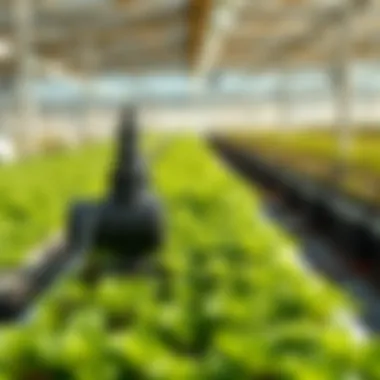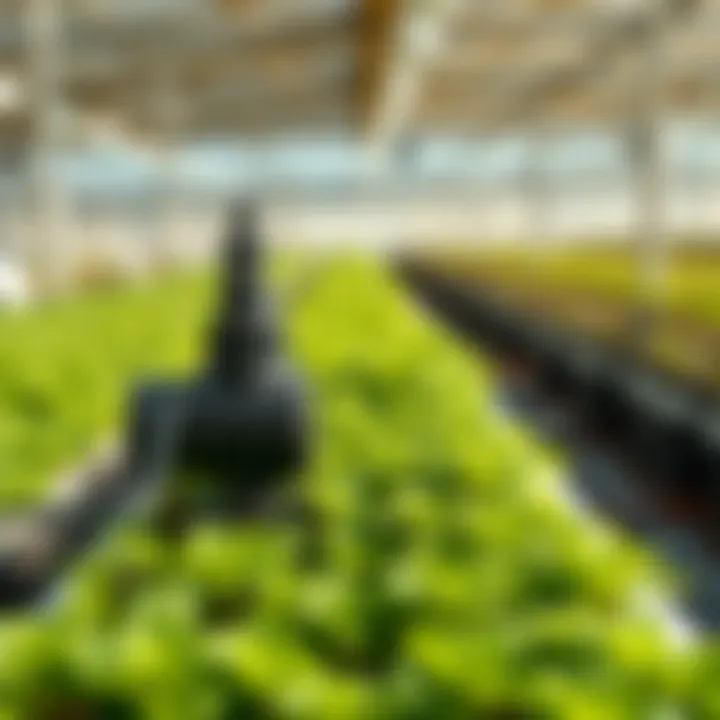Essential Insights on Hydroponic Reservoir Pumps


Topic Overview
Definition and Importance
In the realm of hydroponics, where plants flourish without soil, the role of reservoir pumps cannot be overemphasized. These pumps are essential components that facilitate the circulation of nutrient-rich water throughout the hydroponic system, ensuring that each plant receives the optimal amount of water and nutrients. Simply put, reservoir pumps act as the lifeblood of hydroponic setups, enabling efficient irrigation and maintaining necessary moisture levels in the grow medium.
Brief History and Evolution
The concept of hydroponics dates back thousands of years, but the technology surrounding reservoir pumps has seen considerable advancements. Early hydroponic systems relied on simple pumps, often cumbersome and inefficient. Over time, as agricultural science expanded and technology advanced, so too did the design and functionality of these pumps.
Today, reservoir pumps come in a variety of types, from submersible to inline models, each engineered to meet specific needs. The innovations in pump design reflect a broader shift toward sustainability in agriculture, with systems designed for energy efficiency and ease of maintenance. The evolution of these pumps enables hydroponics to not only enhance food production but also to address environmental challenges in a manner that aligns with modern sustainable farming practices.
Intro to Hydroponic Systems
In the realm of modern agriculture, hydroponic systems are emerging as a game-changer. These systems enable growers to cultivate plants in a nutrient-rich water solution, rather than in traditional soil. What’s fascinating is that this method magnifies the efficiency of resources—making it an ideal approach for both home gardeners and commercial farmers alike.
Definition of Hydroponics
So, what exactly is hydroponics? To put it plainly, hydroponics is a method of growing plants without soil. Instead, plants are supported in a medium—like coconut coir or pebbles—while their roots are submerged in a mineral nutrient solution. It’s a little like giving plants their own swimming pool, but instead of water, it’s filled with nutrients that promote growth. This approach allows for precise control over nutrient delivery, which can lead to faster growth rates and higher yields compared to conventional farming.
Importance of Water in Hydroponics
Water plays a monumental role in hydroponics. In this system, it’s not just a matter of watering the plants; it’s about perfectly balancing the flow of water and nutrients to ensure plants thrive. The lack of soil means that any imbalance can be immediately addressed, allowing for a level of precision unattainable in soil-based agriculture.
The significance of water management can be summed up as follows:
- Nutrient Absorption: Water serves as a vehicle for nutrients to reach plant roots. Without water, plants can’t access essential minerals, leading to stunted growth.
- Oxygen Supply: Dissolved oxygen in water helps roots respire. It’s vital for their health, ensuring they don’t suffocate due to over-saturation.
- Temperature Control: Water helps regulate the temperature in growing systems, which is crucial for optimal plant development.
In closing, understanding how hydroponic systems work, particularly the roles of water and nutrients, sets the foundation for delving deeper into components like reservoir pumps. These pumps are vital to the operation, making it essential for both novices and seasoned growers to grasp their significance. Whether you’re growing herbs in your apartment or managing a large-scale operation, the principles remain the same, and the potential rewards are substantial.
Role of Reservoir Pumps in Hydroponics
In the world of hydroponics, the role of reservoir pumps cannot be overstated. These pumps are the lifeblood of hydroponic systems, ensuring that plants receive the essential nutrients and water they require for growth. Without these pumps, the entire operation can falter, leading to poor plant health and decreased yields. Their functionality directly impacts both the efficiency of nutrient delivery and the overall effectiveness of the hydroponic system.
The pumps facilitate the movement of the nutrient solution from the reservoir to the plants, enabling precise control over the delivery. This means that farmers can accurately provide required nutrients and manage water consumption better than traditional soil-based methods. In hydroponic setups, where every drop of water counts, reservoir pumps play a critical part in resource management.
Functionality of Reservoir Pumps
Reservoir pumps function by creating a consistent flow of nutrient solution, ensuring that plants receive a steady supply. The mechanics behind this involve different pump types, which vary in terms of design and operation but all serve the same fundamental purpose: to transport the nutrient mix effectively. Typically, these pumps work in tandem with a timer or automated system, allowing for timed delivery that mimics natural watering cycles.
Additionally, the pumps can be set to adjust flow rates, adapting to the specific needs of different plants. For instance, seedlings might require a gentler flow, while more mature plants can handle a more robust delivery. The adaptability of these pumps means that they can cater to various systems, whether it’s a deep water culture or a nutrient film technique setup.
Types of Hydroponic Reservoir Pumps
When it comes to types, hydroponic reservoir pumps are generally categorized into several groups. Understanding the differences among them can greatly aid in selecting the right pump for your system:
- Submersible Pumps: These pumps are submerged in the nutrient reservoir. They are often quieter and effective for smaller systems. However, they can be harder to access for maintenance.
- Inline Pumps: Not submerged, these sit outside the reservoir and make maintenance easier. They tend to be louder and are useful for larger systems requiring more power.
- Diaphragm Pumps: Known for their ability to handle both nutrient solutions and air, diaphragm pumps are versatile options. They require more effort to adjust but excel in durability.
- Peristaltic Pumps: These utilize rollers to compress a tube, pushing liquid through it. They are ideal for precise dosing, making them a favorite in systems requiring specific nutrient concentrations.
Each type of pump has its pros and cons, and the selection should depend on specific system requirements, including the scale of hydroponic operations and the plants being cultivated.
"The right reservoir pump is often the difference between a thriving hydroponic setup and a struggling garden."
Selecting the appropriate pump is crucial, as it can make or break the hydroponic experience. Consider both your current system and future expansions when making this choice. For further insights and guides on hydroponic systems, visit Hydroponics Wiki.
Selecting the Right Hydroponic Reservoir Pump
Choosing the right hydroponic reservoir pump is a cornerstone of establishing a successful hydroponic system. The pump's efficiency directly influences not just water delivery, but ultimately the health and growth of your plants. It’s not merely about finding a piece of equipment; it’s about - quite literally - setting the right flow for your venture.


When selecting a pump, one must assess both the needs of the hydroponic system and the unique characteristics of the pump itself. Not all pumps are created equal; some may be better suited for larger systems while others thrive in smaller setups. Getting it wrong could mean the difference between a thriving crop and a failed harvest.
Assessing System Requirements
Before picking a pump off the shelf, it's wise to evaluate your hydroponic setup. Are you operating a small indoor garden or managing a large-scale commercial farm? Each scenario has distinct demands. Factors such as the size of your reservoir, the type of hydroponic system (like nutrient film technique or deep water culture), and the plant types you're nurturing, play vital roles. Consider also the distance the water must travel - pump specifications often dictate how high or far the water can be moved effectively. Inadequate power could result in insufficient water delivery, leading to nutrient deficiencies for your plants.
Key Specifications to Consider
Flow Rate
Flow rate, measured in gallons per hour (GPH) or liters per hour (LPH), is a fundamental consideration. This specification indicates how much water the pump can move over a given time frame. A higher flow rate is beneficial for systems that require rapid turnaround of water circulation, ensuring nutrients get delivered swiftly and effectively. However, it's crucial to balance the flow rate with the needs of your plants; too much water can lead to saturation, while too little can hinder growth.
"Finding the correct flow rate is like playing Goldilocks—you need it just right."
Some pumps offer adjustable flow rates, allowing for flexibility as plant needs change. Whether you are working with leafy greens or more robust fruit-bearing plants, the adaptability of the pump's output can be a hallmark of its utility in diverse growing conditions.
Power Consumption
Next is power consumption, best described by wattage. The energy efficiency of your chosen pump affects both your wallet and your environmental footprint. Energy-efficient pumps may have higher upfront costs, but they often pay for themselves in lower electricity bills over time. It’s wise to calculate the total operational expenses since some pumps can become real power guzzlers when running continuously.
In addition, a low-wattage pump that blends performance with energy efficiency can be particularly appealing for growers aiming for sustainability. This becomes especially significant when considering the overall ecological impact of hydroponic farming.
Noise Level
Last but not least, consider the noise level of the pump. While this may not seem as pressing as flow rate or power usage, a pump that operates quietly can make a substantial difference in user experience, particularly in indoor setups. Constant hums and whirrs can disrupt a tranquil environment or become an annoyance over time. Opting for pumps labeled as 'quiet' can spare you the inconvenience of unwanted background noise while working or relaxing near your hydroponic system.
In summary, selecting the right hydroponic reservoir pump isn't just about acquiring a tool; it's about understanding your system dynamics. From assessing system requirements to weighing specifications like flow rate, power consumption, and noise levels, this careful selection process sets the groundwork for fruitful growth. A thoughtful approach can make your hydroponic garden not merely functional, but flourishing.
Installation of Hydroponic Reservoir Pumps
The installation of hydroponic reservoir pumps holds a crucial position in the overall framework of hydroponic systems. A proper setup is not just about getting water from one place to another; it’s about ensuring that plants receive a steady, reliable supply of nutrients mixed with water—essentially the lifeblood of your hydroponic system. Getting the installation right can enhance efficiency, minimize malfunctions, and ultimately boost crop yield.
A well-installed pump not only contributes to the optimal functioning of your hydroponic setup, but it also paves the way for easy maintenance and troubleshooting down the line. Considerations for size, placement, and electrical connection are vital aspects that can't be overlooked.
Preparation Steps
Before you begin the installation, preparing adequately can save you from unnecessary headaches. Here’s what to keep in mind:
- Select the Right Location: The spot where you place the pump is almost as significant as the pump itself. It should be easily accessible for maintenance but also positioned close to the reservoir and the grow system to minimize the length of tubing required.
- Gather the Necessary Tools and Materials: Think about the equipment you need before diving in. Common tools include screwdrivers, wrenches, and a level to ensure the pump is sitting right. Additionally, make sure you have tubing, connectors, and clamps at your disposal.
- Clean the Area: Dust and debris can impede the pump’s performance. A clean workspace allows an efficient installation without any distractions caused by loose materials.
- Read Instruction Manual: Before you plug anything in, familiarize yourself with the manufacturer’s guidelines for your specific pump. Each model has its unique instructions and specifications which can greatly influence the installation process.
Connecting the Pump to the System
Connecting the pump to your hydroponic system flows logically from preparation. Here’s how you can approach this step systematically:
- Secure the Connections: Begin by attaching the tubing from the reservoir to the pump inlet. Use hose clamps to ensure it fits snugly; you don’t want any leaks!
- Position the Outlet: Next, direct the outlet tubing to the system that distributes the nutrient solution to your plants. Proper angling and securing of this tubing can make a big difference in solution flow and delivery efficiency.
- Electrical Hookup: If your pump is electric, connect it to a power supply. Make sure that the voltage matches what’s specified by the manufacturer. An improperly connected pump can be a customer for electrical repairs down the road.
- Test the System: Once everything is connected, perform a test run. Check for leaks, listen for irregular noises, and ensure the water flows at the expected rate. Note that a trial period is essential to guarantee the functioning of the pump.
- Final Adjustments: After testing, adjust if necessary. Ensuring that every component is in sync can save you trouble later.
"Proper preparation and connection of the pump system sets the tone for a vibrant and healthy hydroponic garden."
Maintenance of Hydroponic Reservoir Pumps
Maintaining hydroponic reservoir pumps is crucial to the overall efficiency and effectiveness of a hydroponic system. A well-maintained pump ensures that nutrient solutions circulate seamlessly, promoting healthy plant growth. Neglecting regular maintenance can lead to several complications, including clogged filters, decreased efficiency, or even pump failure. Therefore, understanding the importance of routine upkeep is essential for anyone engaged in hydroponic farming.
Not only does proper maintenance extend the lifespan of the pump, but it also contributes to optimal nutrient delivery and water management. The quality of the nutrient solution directly affects your plants; if the system struggles to deliver nutrients, it can hinder growth or cause deficiencies. Additionally, maintaining a clean and functional reservoir pump prevents stagnant water—a breeding ground for pests and diseases—which can devastate entire crops.
Routine Cleaning Procedures
Regular cleaning is a linchpin in the maintenance of hydroponic reservoir pumps. Over time, sediment, algae, and nutrient buildup can clog the pump components, reducing its efficacy. Here's an outline of routine cleaning procedures you can implement:


- Frequency: Ideally, check and clean your reservoir pump every two weeks, or weekly during peak growing seasons.
- Materials Needed: Prepare a soft brush, non-abrasive sponge, bucket, and mild cleaning agents like vinegar or hydrogen peroxide to disinfect the pump.
- Steps for Cleaning:
- Disconnect the pump from the power source to ensure safety.
- Remove the pump from the reservoir and detach any hoses or fittings.
- Flush the pump with clean water to remove loose debris and sediment.
- Scrub the exterior and interior parts with a soft brush or sponge, ensuring that all surfaces are clean.
- Soak the pump components in the cleaning solution for about 15-30 minutes to eliminate stubborn buildup.
- Rinse thoroughly with clean water to ensure no cleaning agents remain.
- Allow everything to dry completely before reassembly.
- Reassemble the pump and reconnect to the system; ensure all fittings are secure.
Troubleshooting Common Issues
Sometimes, despite all efforts, you may encounter issues with your hydroponic reservoir pump. Issues like unusual noise, poor water flow, or overheating signal a problem that needs addressing. A proactive approach to troubleshooting can save time and prevent further complications.
- Unusual Noises: If the pump is making loud or grinding noises,
- Poor Water Flow: This might indicate a clogged line or worn pump.
- Overheating: Excessive heat can be a sign of pump stress or blockage.
- Check for Blockages: Inspect the intake screen and impeller for debris. Clear any clogs to restore proper function.
- Lubrication: Ensure that moving parts are well-lubricated according to the manufacturer's recommendations.
- Inspect Hoses: Look for kinks or blockages in the hoses connected to the pump.
- Evaluate Pump Performance: If the pump is functioning intermittently or not at all, consider recalibrating or replacing it if needed.
- Check the Wiring: Ensure that the electrical connections are intact and not causing short circuits.
- Cooling Off: Give the pump a break if it feels extremely hot, and double-check that it's not running continuously without rest.
Taking the time to address these common issues will yield better results in your hydroponics endeavors and ultimately enhance the success of your plants.
Regular maintenance and immediate attention to problems are vital for a thriving hydroponic system. Small actions can prevent large headaches down the line.
Impact on Plant Growth
Understanding how hydroponic reservoir pumps affect plant growth is fundamental for anyone diving into this method of agriculture. Proper functioning of these pumps directly correlates with the efficiency of nutrient delivery and water management, essential components for thriving plants.
When we talk about the importance of reservoir pumps, we must acknowledge that plants depend on timely and consistent access to nutrients dissolved in water. If the pump malfunctions or lacks optimal delivery capabilities, it could lead to nutrient deficiencies, consequently stunting growth. A malfunctioning pump can literally put a damper on the entire hydroponic system, showing just how pivotal these devices are for developing healthy produce.
Nutrient Delivery Efficiency
Efficient nutrient delivery stands at the forefront of hydroponics success. Reservoir pumps are not just about moving water; they are about delivering nutrients precisely when and how the plants need them.
- Precision Matters: Plants absorb nutrients at different rates depending on their growth stages. For instance, young seedlings may need fewer nutrients compared to mature plants. A quality pump allows operators to adjust the flow and nutrient concentration dynamically, catering to these changing needs.
- Mixing Capabilities: Reservoir pumps also contribute to maintaining the ideal nutrient solution. A good pump ensures that nutrients are consistently mixed, preventing any potential settling that could cause inconsistencies in what the plants receive.
Furthermore, the design and type of the pump can significantly impact this delivery. For example, centrifugal pumps are often preferred in hydroponic systems due to their ability to maintain a steady flow of nutrient solution, which is ideal for keeping hydration and nutrient levels stable.
Water Management Strategies
Effective water management strategies are closely tied to the functionality of hydroponic reservoir pumps. Without proper management, growers may face issues such as root rot, algae growth, or even system failures.
- Recirculation: One key strategy involves recirculating water within the hydroponic system. The reservoir pump plays a crucial role here, helping to reintroduce unused nutrient solutions back into the reservoir, thus conserving water and nutrients. This not only reduces resource waste but also maintains a balanced nutrient mix ready for plants.
- Drainage Control: Another critical aspect of managing water is ensuring that excess water is drained effectively. If stagnant water accumulates, it can lead to detrimental effects like increased algae growth or root diseases. The right pump setup allows for easy drainage, avoiding these issues while keeping the root environment healthy.
The relationship between hydroponic reservoir pumps and plant growth is not simply a matter of mechanics; it also involves understanding the biological needs of the plants within the system. Therefore, ensuring an efficient pump system can be the difference between a bountiful harvest and a disappointing yield.
"In hydroponics, every component, from light to pumps, has a role in nurturing the delicate balance plants require to flourish."
This highlights the need for persistent monitoring and adjusting of both nutrient delivery and water management methods to adapt to the diverse needs of plants throughout their life cycle. By keeping these considerations in check, growers can pave the way for healthier plants and, ultimately, a more successful hydroponic venture.
Comparative Analysis of Reservoir Pumps
When diving into the world of hydroponic systems, different types of reservoir pumps play distinct roles, influencing not only the operation but also the success of plant cultivation. The comparative analysis of these pumps sheds light on their pros and cons, aiding farmers in making informed choices that align with their unique hydroponic setup.
Electric vs. Manual Pumps
When discussing reservoir pumps, the debate between electric and manual pumps often takes center stage. Each type comes with its own set of advantages and disadvantages, which can significantly impact your hidroponic system's efficiency and management.
Electric Pumps have become the standard for many hydroponic enthusiasts. They're often favored due to their efficiency and consistency. Electric pumps can deliver a steady flow of nutrient-rich water to plants, ensuring they receive the nourishment they need without constant human intervention. They also come in various styles — submersible, inline, and diaphragm pumps being common examples. When properly chosen, they can cover larger areas and manage multiple plants effortlessly.
However, they are not without their downsides. Electric pumps necessitate a power source, which might pose a challenge in areas with unreliable electricity. Additionally, they tend to be pricier, and their ongoing operating costs can add up. If they malfunction, they require prompt repairs, or else your plants might suffer from lack of nutrients.


"In hydroponics, a reliable pump isn’t just a convenience; it's a necessity for plant health."
On the other hand, Manual Pumps offer a more hands-on approach. Ideal for small-scale operations or hobbyists, these pumps do not rely on electricity, making them easier to use in remote locations. They can be less costly, both in upfront expenses and in long-term maintenance. For those who enjoy the tactile engagement with their plants, this simplicity can be a refreshing advantage.
However, the trade-off is that manual pumps require physical labor and are less efficient. They may not provide the same steady water delivery that electric pumps can achieve. For anyone scaling up their hydroponic system, manual pumps may quickly become impractical.
Cost-Benefit Analysis
Understanding the financial implications of selecting a reservoir pump is crucial. The initial investment may vary widely between electric and manual options, but the long-term costs can further narrow down your ideal choice.
Advantages of Electric Pumps:
- Efficiency: They often provide consistent water flow, promoting healthier plants.
- Automation: Reduced manual labor means time saved for farmers.
- Versatility: Suitable for diverse hydroponic systems from NFT to deep water culture.
Disadvantages of Electric Pumps:
- Energy Costs: Higher ongoing expenses depending on usage.
- Reliability on Power: Outages could disrupt plant care.
- Initial Costs: Generally more expensive at purchase than manual pumps.
Advantages of Manual Pumps:
- Low Initial Costs: Typically cheaper than electric variants.
- No Energy Dependency: Function in any environment; useful during outages.
- Engagement: Offers the chance for hands-on involvement.
Disadvantages of Manual Pumps:
- Labor Intensive: Requires physical effort, which can be tiring.
- Inconsistent Flow Rates: Harder to regulate, potentially stressing plants if not monitored regularly.
- Limited Scale: Best suited for small areas, becoming inefficient for larger setups.
The choice between electric and manual pumps boils down to what you prioritize in your hydroponic endeavor. A meticulous analysis of your specific needs and the context of your agricultural setup will guide you to the pump that best aligns with your objectives.
Future Trends in Hydroponic Pump Technology
As the world moves toward sustainable agricultural practices, the demand for innovative and efficient hydroponic reservoir pumps is on the rise. This section dives into unique advancements that are shaping the future of hydroponic pump technology, demonstrating their significance in enhancing crop production and promoting ecological well-being. Hydroponic farmers, both novice and seasoned, can gain a competitive edge by staying informed on these trends.
Innovations in Pump Design
The modern landscape of hydroponic pump design is evolving rapidly. One key innovation is the rise of smart pumps that integrate IoT (Internet of Things) technology. These devices automatically monitor system conditions — such as flow rates and water levels — and adjust their operation in real-time. Such capability not only conserves energy but also ensures that plants receive consistent nutrient flows.
New materials are also shaking things up. Instead of traditional plastics, many manufacturers are experimenting with bio-based and recyclable materials. This not only reduces the carbon footprint associated with pump production but also addresses waste management concerns down the line.
Moreover, manufacturers are exploring modular designs, allowing for easier upgrades and repairs. This can save farmers considerable downtime and money compared to older, fixed design pumps that often require complete replacement.
Sustainable Practices and Eco-Friendly Options
Sustainability is not just a buzzword; it’s becoming essential in all sectors, including hydroponics. Many pump manufacturers are now prioritizing eco-friendly solutions. One prominent trend is the development of energy-efficient models that significantly reduce power consumption. For example, some pumps are designed to operate on solar power. This cuts costs and distinguishes growers as environmentally conscious operators.
Furthermore, recycling programs for old pumps are gaining popularity. Some manufacturers and retailers offer incentives for returning used pumps, which are then refurbished or recycled, thereby promoting a circular economy in the farming sector.
"The transition to sustainable practices is no longer optional; it is essential for the longevity of our planet and the agriculture industry."
Additionally, there is an increase in the use of regenerative design principles in pump systems. By implementing gravity-fed reservoirs and kinetic energy recovery systems, farmers can create setups that rely less on traditional power sources. It’s all about harnessing nature’s potential, reducing reliance on external resources, and creating systems that operate in harmony with the environment.
In summary, the world of hydroponic reservoir pumps is moving towards more advanced, efficient, and eco-friendly designs. By understanding these trends, farmers can enhance productivity while contributing positively to our world.
Culmination
As this article draws to a close, it's vital to reflect on the key insights discussed regarding hydroponic reservoir pumps. These conduits of circulation and delivery are not merely components of hydroponic systems but are fundamental to their success. Understanding their functionality, maintenance, and future developments allows growers to optimize their crop production effectively.
Summary of Key Points
To encapsulate the essence of what we examined:
- Functionality: Reservoir pumps serve the critical role of ensuring a consistent supply of nutrient-rich water to plants, greatly affecting growth and yield.
- Types: Knowing the types of pumps available allows growers to select models that best fit their specific system needs, whether it be electric or manual pumps.
- Selection Criteria: It’s imperative for growers to take into account flow rates, power consumption, and noise levels when choosing their pumps. This selection can affect overall efficiency and operating costs.
- Maintenance: Regular cleaning and troubleshooting practices ensure these pumps operate effectively over time, minimizing potential setbacks during a growing cycle.
- Impact on Growth: The effectiveness of reservoir pumps directly correlates with nutrient delivery efficiency and overall plant health, making them central to hydroponic success.
- Future Trends: Innovations in pump technology could usher new practices, promising sustainability and increased efficiency in hydroponic farming.
Encouragement for Ongoing Learning
The field of hydroponics is ever-evolving, and staying informed is paramount for both novice and experienced agriculturists. Continuous education on emerging technologies and techniques can yield significant benefits. Engage with community forums on platforms like Reddit, study research from agricultural institutions, or read current articles at **.edu or *.gov sites to deepen your knowledge. Readiness to adapt and learn exudes a commitment to not only personal growth but also to sustainable practices in agriculture. Hydroponics is not just about pumps and systems; it’s a holistic approach to cultivating the future of food. Keep pushing your boundaries, and let curiosity guide your journey into the world of hydroponics.



